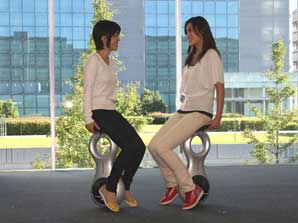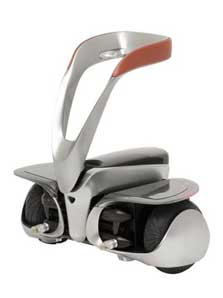Web Japan > Trends in Japan > Sci-tech > Advances in Personal Mobility
Advances in Personal Mobility
New Devices Merge Car Technology with Robotics
Japanese carmakers are making big strides in the field of "personal mobility technology," or one-person devices for taking people from one place to another. Honda and Toyota have each unveiled machines that allow users to travel in whatever direction they choose simply by shifting their body weight. By combining their work in robotics development with their expertise in automotive technology, these two Japanese firms are establishing a growing presence in this burgeoning field.
Forwards, Backwards, and Side to SideIn September 2009 Honda Motor unveiled the U3-X, a single-wheeled experimental device providing seated transportation for a single user. The most remarkable feature of the U3-X is its advanced balance-control mechanism, which is a fruit of Honda's long-running work in developing the ASIMO bipedal robot. Enabling ASIMO to move stably on two feet required technology that could sense a shift in the robot's weight and adjust its balance accordingly. Harnessing this technology, the U3-X is able to stand upright on its single wheel when stationary, and when a user sits upon the device and shifts his or her bodyweight, an incline sensor determines which direction the user wishes to go and at what speed. The U3-X itself remains upright, allowing passenger and machine to move as one.

How the U3-X works. (C)Honda Motor Co., Ltd.
Another of its outstanding features is the ability to move laterally. Within the wheel housing are a series of small wheels connected in line to form the single, large-diameter main wheel. The main wheel is used to move forwards and backwards, while the many smaller wheels rotate perpendicular to the main wheel for moving side to side. Moving both the larger and smaller wheels simultaneously lets the U3-X move diagonally. Honda's groundbreaking new technology thus allows the multi-wheel vehicle to provide users with smooth movement in whatever direction they desire.
Ultra-Compact Personal TransportIn August 2008 Toyota Motor unveiled the Winglet, a two-wheeled personal transport assistant robot. The Winglet is similar in appearance to the US-made Segway. A smaller motor and drive unit, however, has enabled Toyota to make the Winglet much more compact, and at roughly 10 kilograms, its weight is a mere fraction of the Segway's. Since it is only about as wide as the average human being, the device also has the advantage of being well suited for indoor use.
Like Honda's U3-X, users set the Winglet in motion by shifting their body weight backwards or forwards. And thanks to the incorporation of Toyota's proprietary parallel shaft mechanism technology, two of the three different models offer hands-free steering control. (The third is equipped with a steering handle.) The company is now conducting trials of the Winglet in Japan and aims to make it available for sale in the near future. (February 2010)
- Leave Your Chores to a Robot (March 2009)
- The Running Robot (March 1, 2006)


